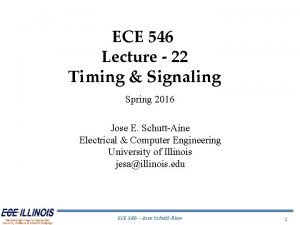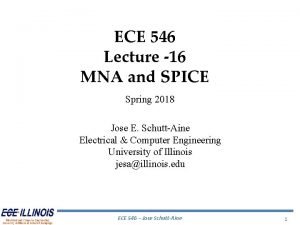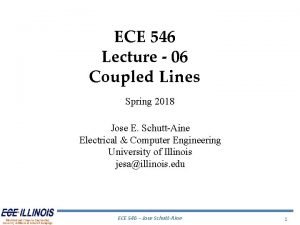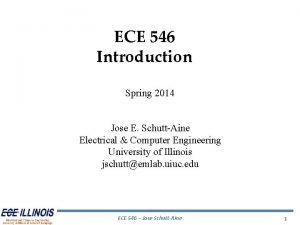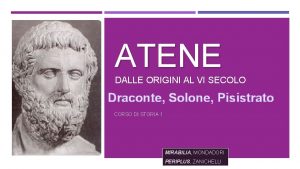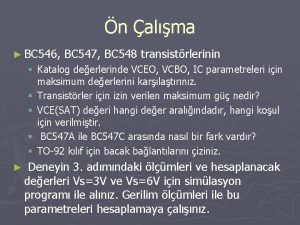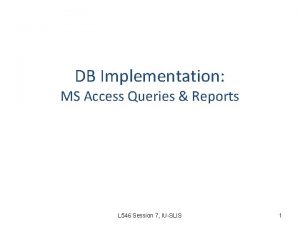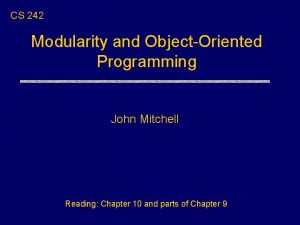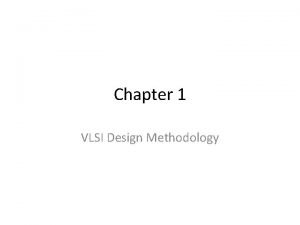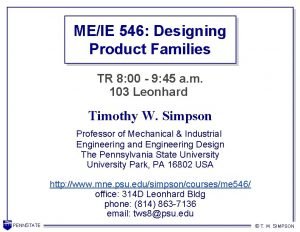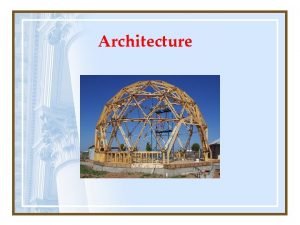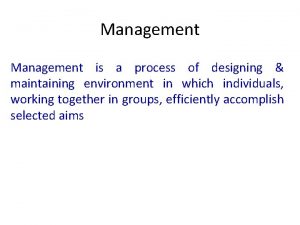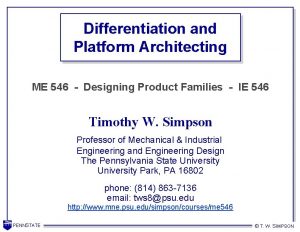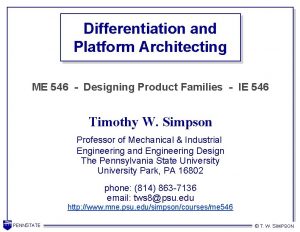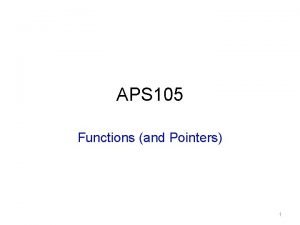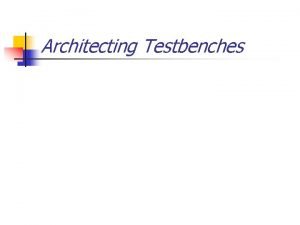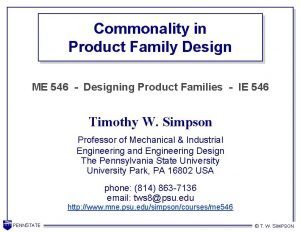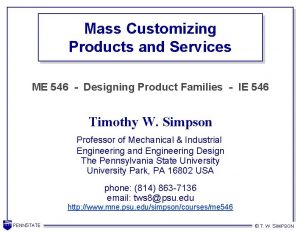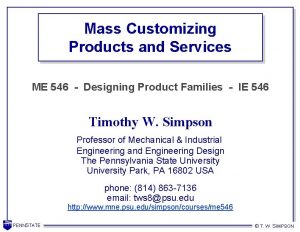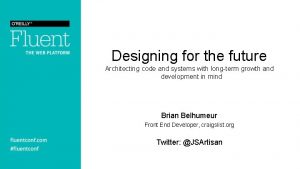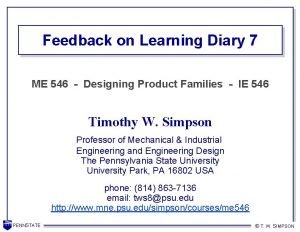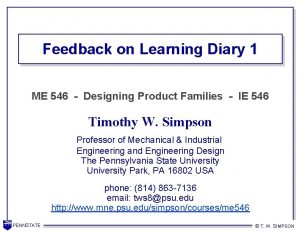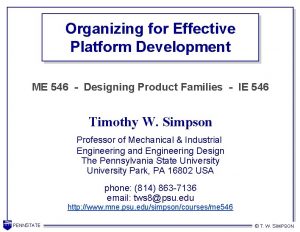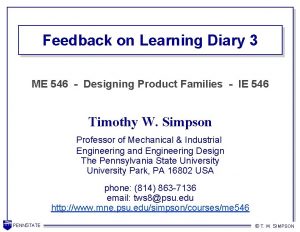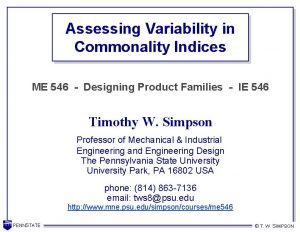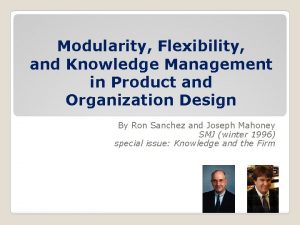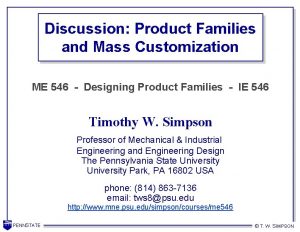Modularity and Product Architecting ME 546 Designing Product






























- Slides: 30

Modularity and Product Architecting ME 546 - Designing Product Families - IE 546 Timothy W. Simpson Professor of Mechanical & Industrial Engineering and Engineering Design The Pennsylvania State University Park, PA 16802 phone: (814) 863 -7136 email: tws 8@psu. edu http: //www. mne. psu. edu/simpson/courses/me 546 PENNSTATE © T. W. SIMPSON

Degree of Market Turbulence Recall: Pine’s Five Steps to Mass Customization Provide Quick Response 5 4 Modularize 3 2 1 Create Point-of-Delivery Customization Embed Customizability Customize Services Degree of Organizational Turbulence Sources: • Pine, B. J. , II, 1993, "Mass Customizing Products and Services, " Planning Review, Vol. 22, No. 4, pp. 6(8). • Pine, B. J. , II, 1993, Mass Customization: The New Frontier in Business Competition, Harvard Business School Press, Boston, MA. PENNSTATE © T. W. SIMPSON

Overview of Today’s Lecture • MODULARITY IS THE KEY enabler for successful product family design and product platforms. • What is product architecture? What types exist? • What is modular design? What is its role in product family and product platform design? • What is an interface? What is a module? • What are the different types of modularity? • What is a function? What is a function structure? PENNSTATE © T. W. SIMPSON

Architecture Beach PENNSTATE Source - www. coolhouseplans. com Contemporary © T. W. SIMPSON

System Architecture System Boundary Slide adapted from O. de Weck & T. Simpson, MIT ESD 39 s PENNSTATE © T. W. SIMPSON

Architecture: Definition • Architecture q The embodiment of concept, and the allocation of physical/informational function (process) to elements of form (objects) and definition of the structural interfaces among the objects • Consists of: Function q Related by Concept q To Form q Function Form Concept Slide adapted from O. de Weck & T. Simpson, MIT ESD 39 s PENNSTATE © T. W. SIMPSON

Function-Concept-Form Function: 1) meeting place 2) visible main speaker 3) processions church (Basilica) provide for 1) meeting place 2) visible large “cast” amphitheater provide for 1) meeting place 2) each participant visible to others meeting room Concept: Function: Concept: raised provide for Form Often Follows Function Slide adapted from O. de Weck & T. Simpson, MIT ESD 39 s PENNSTATE © T. W. SIMPSON

Product Architecture • Product architecture is: q “the scheme by which the function of a product is allocated to physical components” (Ulrich, 1995) • Purpose of product architecture is: q “to define the basic physical building blocks of the product in terms of what they do and what their interfaces are to the rest of the device” (Ulrich & Eppinger, 2000) • More formally, a product architecture is (Ulrich, 1995): the arrangement of functional elements q the mapping of functional elements to physical components q the specification of the interfaces among physical components q Sources: • Ulrich, K. , 1995, "The Role of Product Architecture in the Manufacturing Firm, " Research Policy, Vol. 24(3), pp. 419 -440. • Ulrich, K. T. and Eppinger, S. D. , 2000, Product Design and Development (2 nd Ed. ), Mc. Graw-Hill, NY. PENNSTATE © T. W. SIMPSON

Example: Coffee Maker Overall Function Brew Coffee Electricity Supporting Sub-Functions Auxiliary Functions PENNSTATE Water Ground Coffee Beans Store Water Heat Coffee Store Grounds Mix Coffee and Water Store Coffee Grind Beans Coffee Shut-off Heater © T. W. SIMPSON

How to Create a Function Structure 1. 2. 3. 4. 5. Formulate the overall product function Split up overall function into sub-functions Determine simplified functions structure Identify material, energy, and information/signal flows Add secondary/auxiliary functions and flows Source: Pahl, G. and Beitz, W. , 1996, Engineering Design: A Systematic Approach (2 nd Rev. Ed. ), Springer-Verlag, New York. PENNSTATE © T. W. SIMPSON

Morphological Matrix • Search for solution principles to fulfill sub-functions q Identify as many solutions for each sub-function and auxiliary functions as possible • Combine solutions to embody physical concepts Use morphological matrix to identify combinations of solutions q Each combination of solutions will fulfill overall function q • Use expertise and heuristics to eliminate infeasible solution combinations PENNSTATE Morphological Matrix [PB 96] © T. W. SIMPSON

PENNSTATE S 11 Heat Coffee Heat Water Filter · · · Si 1 Store Grounds Water Brew Coffee Mix Coffee Store and Water Coffee Morphological Matrix for Coffee Maker S 12 ··· Osmosis Dissolve ··· S 1 j ··· S 1 m Ionize ··· Stir · Si 2 ··· · · ··· Sij · · · Sn 1 ··· · Sn 2 ··· Snj · Sim · ··· Snm © T. W. SIMPSON

Modular and Integral Architectures Defined • After we identify solutions for each function, we can combine them to identify modules in the architecture • Modularity is defined as (Ulrich and Tung, 1991): 1. there is a one-to-one correspondence between functional elements and physical structures. . . AND. . . 2. unintended interactions between modules are minimized (i. e. , component interfaces are de-coupled). The opposite of modular is referred to as integral A modular architecture (ideally) has: q One physical component/function; de-coupled interfaces while an integral architecture has: q PENNSTATE Coupled interfaces; many functions/physical component © T. W. SIMPSON

Coupled vs. Uncoupled Designs • Axiom: Maintain the interdependence of functional requirements (N. P. Suh, Principles of Design, 1990) Coupled Design Uncoupled Design Reference: Billy Fredriksson, Holistic systems engineering in product development, Griffin , Saab-Scania, Nov. 1994/95 PENNSTATE Slide adapted from O. de Weck & T. Simpson, MIT ESD 39 s © T. W. SIMPSON

Types of Modularity: Slot • In a slot architecture, each module has a different interface with the overall system. • Why different interfaces? q So that various components cannot be interchanged • Examples: q SCSI, Ethernet, and parallel ports on laptop q q PENNSTATE © T. W. SIMPSON

Types of Modularity: Bus • In a bus architecture, there is a common bus to which modules connect via the same interface. • What are the advantages of this type of modularity? • Examples: q Modem and Internet cards on laptop; CD and disk drive q q PENNSTATE © T. W. SIMPSON

Types of Modularity: Sectional • In a sectional architecture, all interfaces are the same type but there is no single element to which modules attach. • What are advantages and disadvantages of a sectional approach? • Examples: q Legos q q PENNSTATE Using a sectional architecture, the assembly is built up by connecting the modules to each other via identical interfaces. © T. W. SIMPSON

Sectional Modularity at Nippondenso • Nippondenso can make 288 different panel meters from variations of 8 modules (17 different parts) PENNSTATE © T. W. ©S T. IMPSON, W. SIMPSON 2001

Products, Modules, and Attributes Product 1 Modules A 1 B 1 C 1 Different products Product 2 Module Attributes Types of Modules: D 1 Common A 1 Variant C 1, C 2 B 2 Unique B 1, B 2, D 1 C 2 PENNSTATE © T. W. SIMPSON

Example: B&D Versapack® Toolkit Common Variant PENNSTATE Variant Unique © T. W. SIMPSON

Creating a Module-Based Product Family 1. Decompose products into their representative functions 2. Develop modules with one-to-one (or many-to-one) correspondence with functions 3. Group common functional modules into a common product platform Product Common 4. Standardize interfaces to Functions Platform facilitate addition, removal, and substitution of modules } Product Family PENNSTATE { Specific Function 1 Specific Function 2 Specific Function k Derivative Product 1 Derivative Product 2 Derivative Product k © T. W. SIMPSON

Example: Braun Family of Coffee Makers Electricity Water Ground Coffee Store Water Heat Coffee Store Grounds Mix Coffee and Water Store Coffee Common Function Brew Coffee Basic Model Water Filter Thermos Karafe Auto Shutoff, Clock Adjustable Heater Frothing Attachment KF 130 KF 145 KF 170 KF 185 KF 190 PENNSTATE © T. W. SIMPSON

Developing Modular Architectures • What are some rules of thumb you, as an engineer, might follow to develop a modular product architecture? q q q PENNSTATE © T. W. SIMPSON

Some Heuristics for Module Development • Stone, et al. (1998) developed a set of three heuristics to identify product modules from a function structure: q q q Dominant Flow: – examines flows through a function structure, following flows until they either exit from the system or are transformed – the sub-functions through which these flows are traced define a module Branching Flows: – examines flows that branch into or converge from parallel function chains – each branch of a flow can become a module; modules interface at point where flow branches or converges Conversion-Transmission: – examines flows that are converted from one type to another – develop a module which converts an energy or material flow into another form and then transmits it PENNSTATE © T. W. SIMPSON

Some Heuristics for Module Development • Zamirowski and Otto (1999) define two heuristics to aid in module identification within a product family: q q Shared Functions: – functional groups which share similar flows and functions and appear multiple times within a product family should be grouped into a single module – this module can then be reused across the product family Unique Functions: – identify functions that are unique to a single product or subset of products – group functions into modules to facilitate product variety PENNSTATE © T. W. SIMPSON

Advantages of Modular Architectures • Facilitates product change and product variety modules can easily be upgraded, degraded, and added-on q modules can easily be reused or replaced q • Modular products can be quickly reconfigured to meet changing market requirements • Improves economies of scale through component and module sharing across products (economies of scope) • • • PENNSTATE © T. W. SIMPSON

Disadvantages of Modular Architectures • Easier to reverse engineer • Modular products tend to sub-optimal • Assembly costs are slightly higher • • PENNSTATE © T. W. SIMPSON

Advantages of Integral Architectures • Facilitates the optimization of “holistic performance characteristics and those that are driven by the size, shape, and mass of a product” [UE 00] • Minimizes redundancy through function sharing • Minimizes number of parts which much be assembled • • • PENNSTATE © T. W. SIMPSON

Disadvantages of Integral Architectures • Difficult to upgrade and reconfigure • Adjusting or “fine-tuning” a single function can be more complex and difficult • Components and modules cannot be easily replaced if worn or broken • • • PENNSTATE © T. W. SIMPSON

Modular vs. Integral Architectures • As product functionality overshoots customer needs, modular architectures become more competitive gy o l o Compete through superior functionality hn c e T g n ni Performance tai s u S t ec it t In h rc l. A a r eg Di ve i t p sru s e ur s re tu c ite h c r A lar u od High Med M y g olo Customer Needs and Expectations Low hn c Te Compete through speed, customization, and convenience Time Adapted from: C. Christensen and M. Verlinden, 2002, "Disruption, Disintegration, and the Dissipation of Differentiability, " Industrial and Corporate Change, vol. 11(5), pp. 955 -993. PENNSTATE © T. W. SIMPSON
 Community detection in networks
Community detection in networks Ece 546
Ece 546 Ece 546
Ece 546 Ece 546
Ece 546 Rd 546/95
Rd 546/95 Ece 546
Ece 546 546-528 a.c
546-528 a.c Significant figures of 546 km
Significant figures of 546 km Bc 547
Bc 547 L 546
L 546 Builder vs buyer in stm
Builder vs buyer in stm Oop modularity
Oop modularity Modularity in vlsi
Modularity in vlsi Basically, product and service designing has
Basically, product and service designing has Managing services marketing
Managing services marketing Examples of product oriented performance based assessment
Examples of product oriented performance based assessment Designing product families
Designing product families -is not one of the purposes for giving oral presentations.
-is not one of the purposes for giving oral presentations. Architecture is art and science
Architecture is art and science The process of designing and maintaining an environment
The process of designing and maintaining an environment Computer aided embroidery and designing
Computer aided embroidery and designing Designing pay levels
Designing pay levels Designing effective hrd programs pdf
Designing effective hrd programs pdf Designing and managing products
Designing and managing products Fleishman job analysis system
Fleishman job analysis system Designing and managing services
Designing and managing services Services are typically produced and consumed simultaneously
Services are typically produced and consumed simultaneously Dialogues
Dialogues Designing and implementing brand strategies
Designing and implementing brand strategies Brand hierarchy levels
Brand hierarchy levels Designing and managing marketing communications
Designing and managing marketing communications

